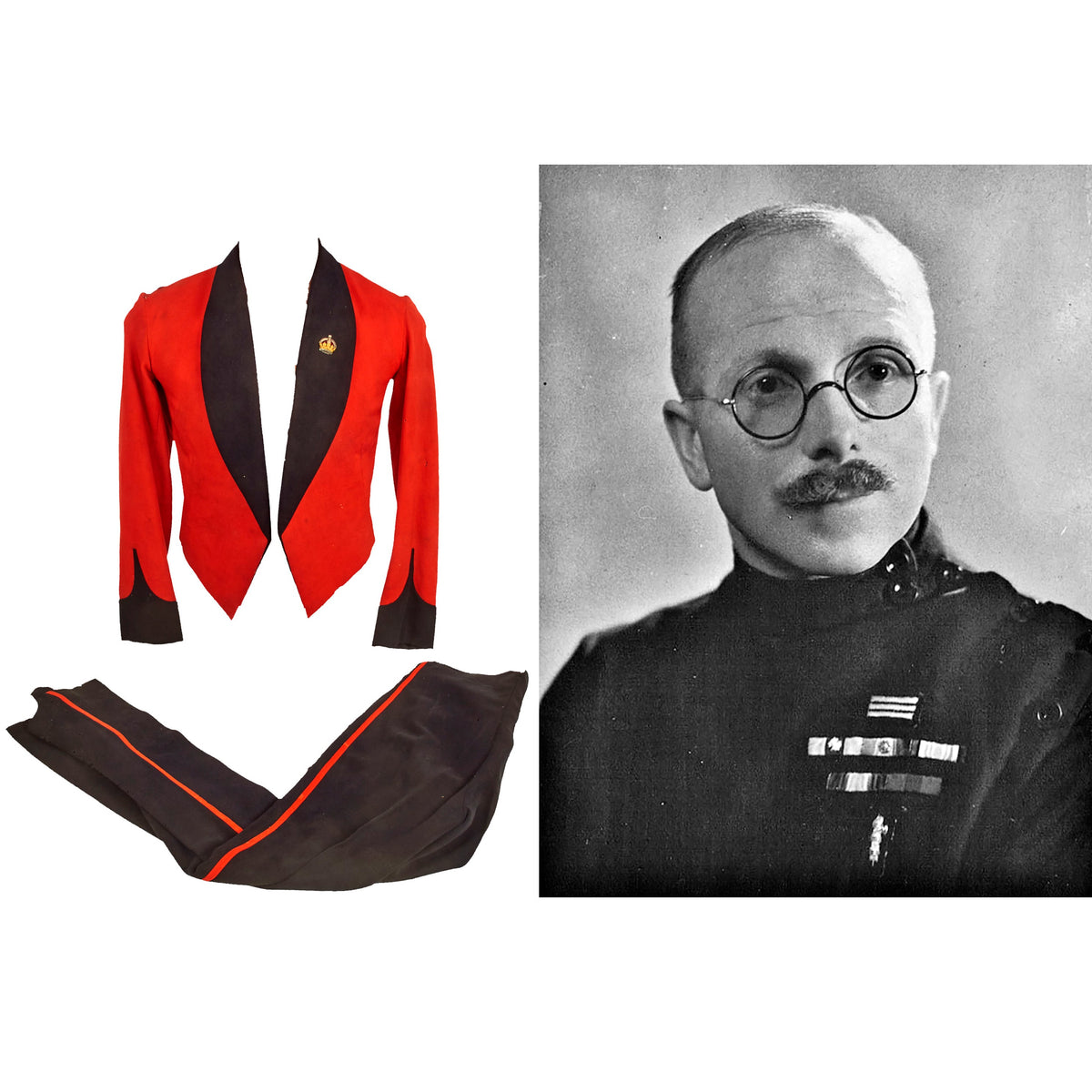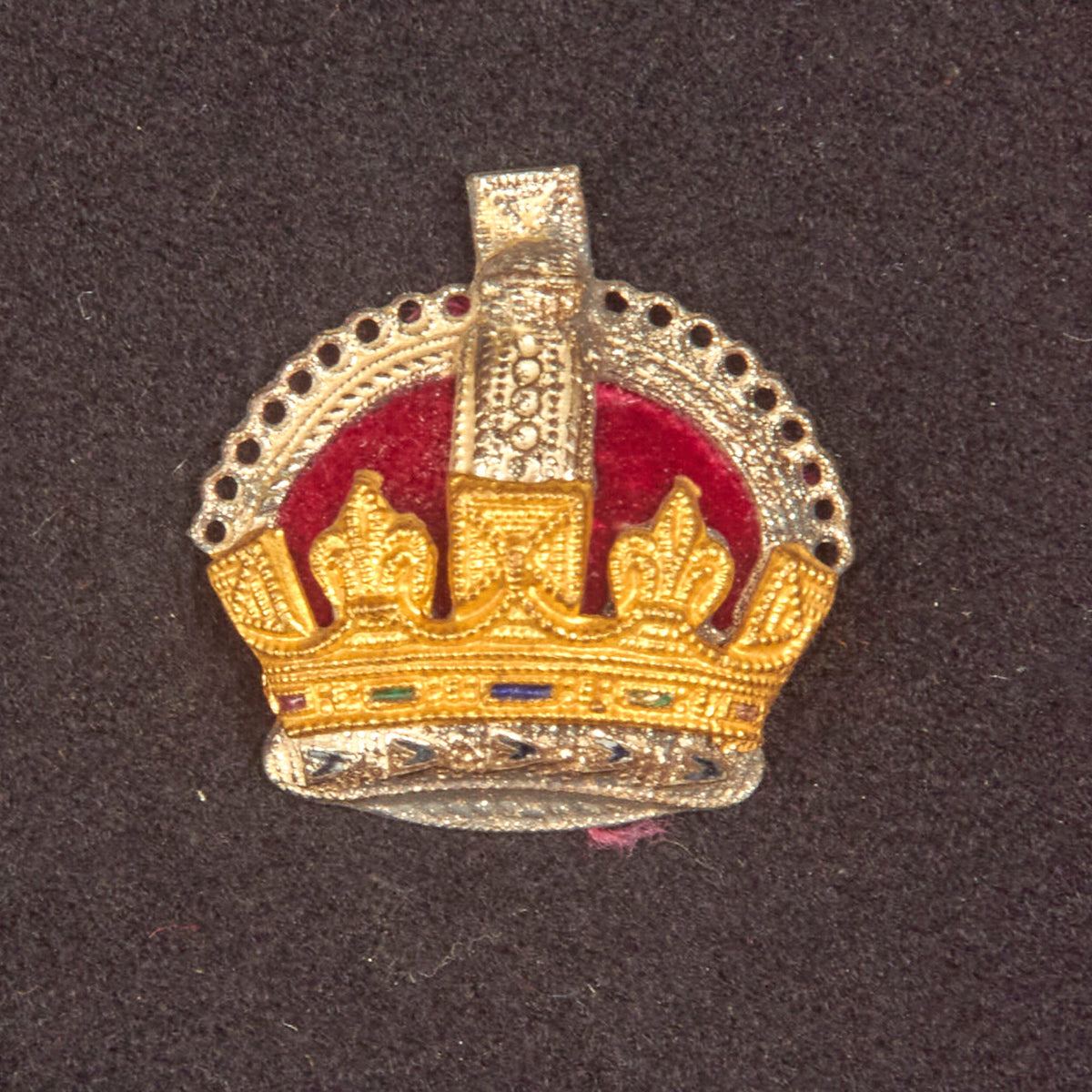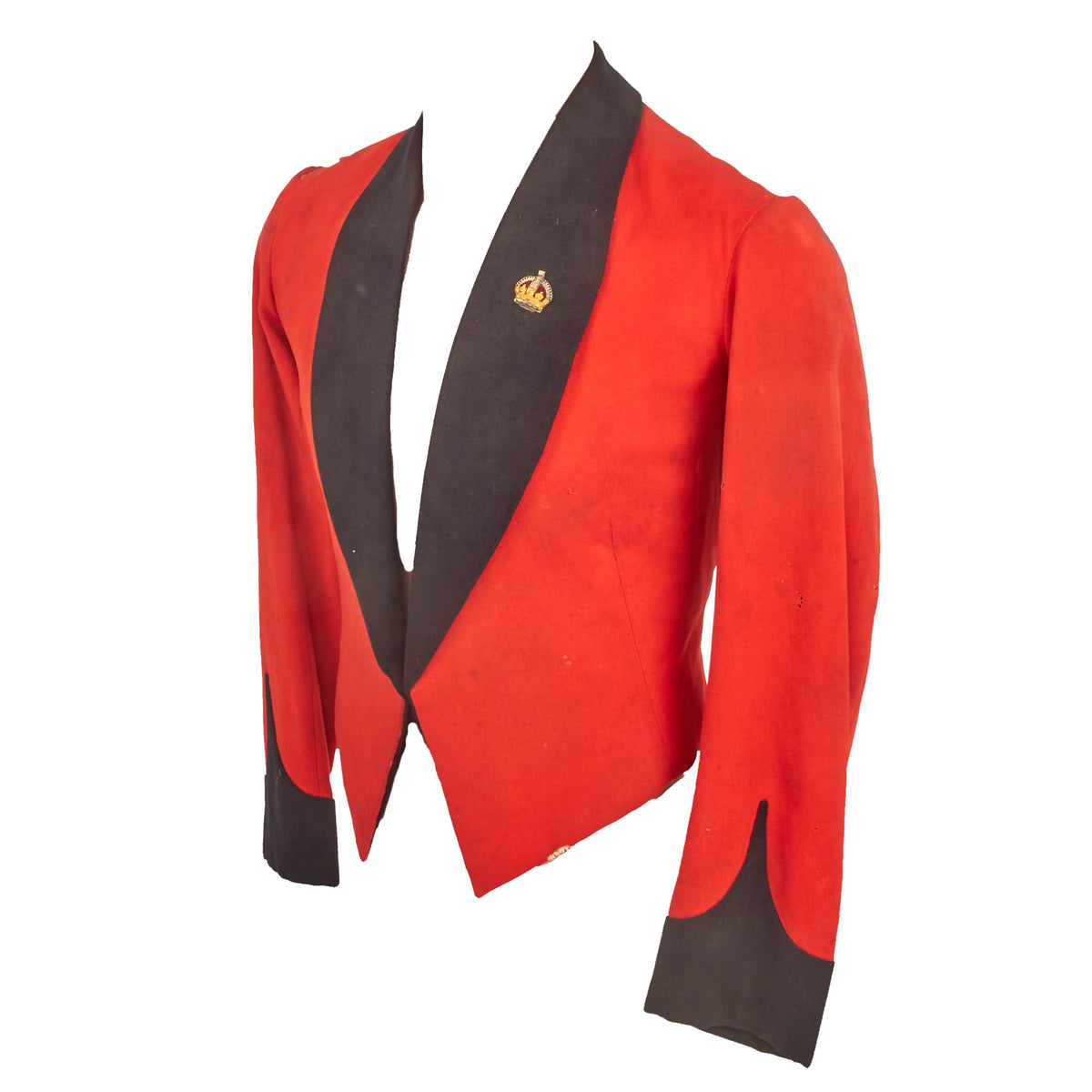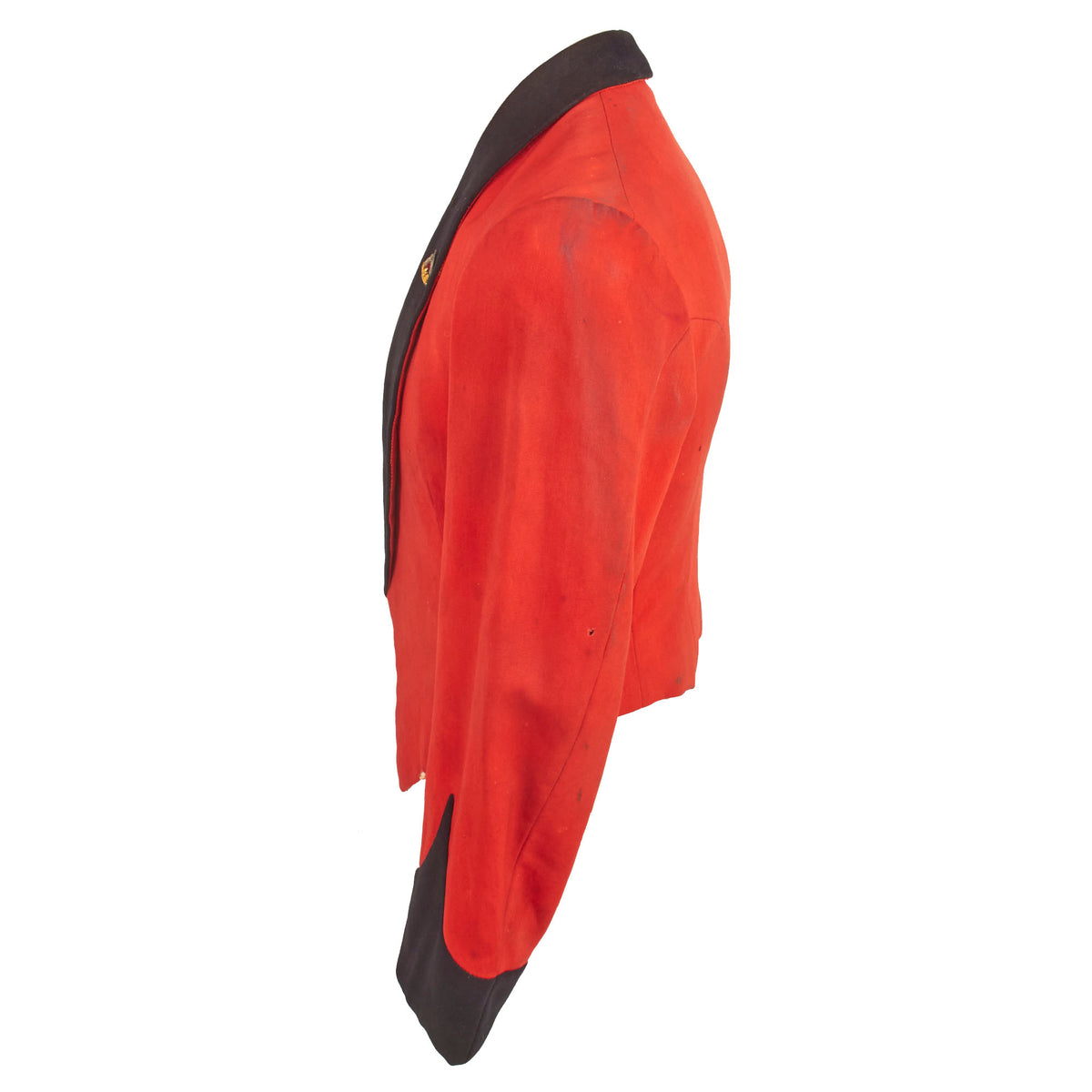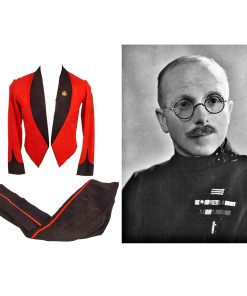Original British WWI Era Royal Irish Fusiliers Scarlet Red Mess Dress Uniform For Lieutenant Charles Steele – Member of British Union of Fascists During WWII Era Original Items
$ 325,00 $ 97,50
Original Item: Only One Available. This was a strange turn of events when further research was conducted. The uniform set is a British mess dress in the famed scarlet red with trousers. Upon further inspection of the interior, we located a small name tag with the name Lieut. C.H. Steel and the unit Royal Irish Fusiliers. With this being our starting point for research, we dove in head first. In the beginning we didn’t discover anything about his military service, instead what we did find was a picture of him taken some time in the late 1930’s wearing a black uniform. The caption accompanying the image of him stated “Lieutenant Charles Steele, a former Royal Irish Fusiliers officer, wearing the uniform of the British Union of Facists or ‘Blackshirts’.”
The British Union of Fascists (BUF) was a British fascist political party formed in 1932 by Oswald Mosley. Mosley changed its name to the British Union of Fascists and National Socialists in 1936 and, in 1937, to the British Union. In 1939, following the start of the Second World War, the party was proscribed by the British government and in 1940 it was disbanded.
The mess dress uniform dates to the WWI era with the possibility of being from the pre war era. British Army mess dress is the formal military evening dress worn by British Army officers and senior non-commissioned officers in their respective messes or at other formal occasions. Mess uniforms first appeared in the British Army in about 1845, initially utilizing the short shell jacket worn since 1831. This working jacket was worn open over a regimental waistcoat for evening dress. The original purpose was to provide a relatively comfortable and inexpensive alternative to the stiff and elaborate full-dress uniforms then worn by officers for evening social functions such as regimental dinners or balls. With the general disappearance of full dress uniforms after World War I, mess dress became the most colorful and traditional uniform to be retained by most officers in British and Commonwealth armies. Immediately after World War II the cheaper “blue patrols” were worn for several years as mess dress, but by 1956 the traditional uniforms had been readopted.
The uniform presents itself quite well but there are a few discrepancies to report. The white cotton lining is now an aged beige color with tearing and material loss mostly present in the shoulder areas. There is moderate staining on both the interior and exterior with scattered areas of minor fraying. The trousers are in the same condition but unfortunately there is tearing scattered along the creases of the trousers.
All in all a wonderful uniform set that would be a great research project. Comes more than ready for display.
Approximate Measurements:
Collar to shoulder: 9″
Shoulder to sleeve: 23”
Shoulder to shoulder: 15.5”
Chest width: 17″
Waist width: 15″
Front length: 24″
Pants:
Waist: 15″
Inseam: 33″
The Royal Irish Fusiliers (Princess Victoria’s) was an Irish line infantry regiment of the British Army, formed by the amalgamation of the 87th (Prince of Wales’s Irish) Regiment of Foot and the 89th (Princess Victoria’s) Regiment of Foot in 1881. The regiment’s first title in 1881 was Princess Victoria’s (Royal Irish Fusiliers), changed in 1920 to the Royal Irish Fusiliers (Princess Victoria’s). Between the time of its formation and Irish independence, it was one of eight Irish regiments.
In 1968, the Royal Irish Fusiliers (Princess Victoria’s) was amalgamated with the other regiments of the North Irish Brigade, the Royal Inniskilling Fusiliers and the Royal Ulster Rifles, to become the Royal Irish Rangers.
The First World War
Regular Army
The 1st Battalion landed at Boulogne-sur-Mer as part of the 10th Brigade in the 4th Division in August 1914 for service on the Western Front and suffered heavy losses at the Battle of Le Cateau in August 1914. The 2nd Battalion landed at Le Havre as part of the 82nd Brigade in the 27th Division in December 1914 for service on the Western Front, but moved to Salonika in December 1915 for service on the Macedonian front before moving on to Egypt for service in Palestine in September 1917. In response to the outbreak of World War One, the 7th Battalion was raised, for the first time, and subsequently commanded, by Colonel Richard S. H. Moody.
The 3rd (reserve) Battalion fought in operations to end the Easter Rising in Dublin in 1916. Two of the Royal Irish Fusiliers were killed and six more wounded.
The 5th (Service) Battalion and 6th (Service) Battalion landed at Suvla Bay in Gallipoli as part of the 31st Brigade in the 10th (Irish) Division in August 1915 but moved to Salonika in October 1915 for service on the Macedonian Front. The 7th (Service) Battalion, commanded by Lieutenant-Colonel Frederic Thornton Trevor Moore, and 8th (Service) Battalion, commanded by Colonel John Southwell Brown, landed in France as part of the 49th Brigade in the 16th (Irish) Division in February 1916 for service on the Western Front. The 9th (Service) Battalion (County Armagh) landed at Boulogne-sur-Mer as part of the 108th Brigade in the 36th (Ulster) Division in October 1915 for service on the Western Front.
Fast Shipping with Professional Packaging
Thanks to our longstanding association with UPS FedEx DHL, and other major international carriers, we are able to provide a range of shipping options. Our warehouse staff is expertly trained and will wrap your products according to our exact and precise specifications. Prior to shipping, your goods will be thoroughly examined and securely secured. We ship to thousands clients each day across multiple countries. This shows how we're dedicated to be the largest retailer on the internet. Warehouses and distribution centres can be located throughout Europe as well as the USA.
Note: Orders with more than one item will be assigned a processing date depending on the item.
Before shipping before shipping, we'll conduct a thorough inspection of the items you have ordered. Today, the majority of orders will be delivered within 48 hours. The delivery time will be between 3-7 days.
Returns
The stock is dynamic and we cannot completely manage it because multiple stakeholders are involved, including our factory and warehouse. So the actual stock may alter at any time. It's possible that you may not receive your order once the order has been made.
Our policy is valid for a period of 30 days. If you don't receive the product within 30 days, we are not able to issue a refund or an exchange.
You can only return an item if it is unused and in the same state as the day you received it. You must have the item in its original packaging.
Related products
Uncategorized
Uncategorized
Uncategorized
Uncategorized
Uncategorized
Band of Brothers ORIGINAL GERMAN WWII Le. F.H. 18 10.5cm ARTILLERY PIECE Original Items
Uncategorized
Uncategorized
Uncategorized
Uncategorized
Australian WWII Owen MK1 Machine Carbine SMG Custom Fabricated Replica with Sling Original Items
Uncategorized
Uncategorized
Uncategorized
Angolan Rebel 1970s era 60mm Inert Display Mortar from Angolan Civil War Original Items
Uncategorized
Uncategorized
Uncategorized
Uncategorized
Uncategorized
Armoured Fighting Vehicles of the World: AFVs of World War One (Hardcover Book) New Made Items
Uncategorized
